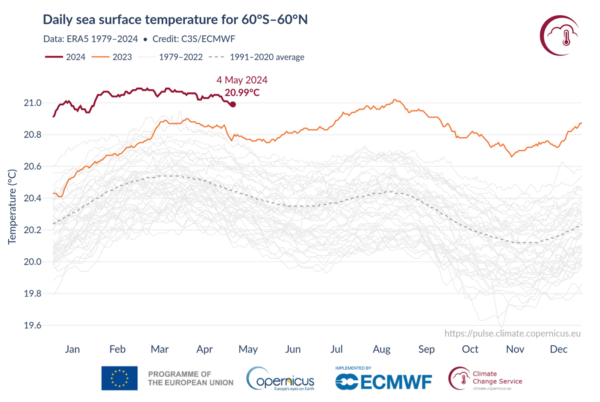The EU’s Copernicus Climate Service have confirmed that April 2024 temperatures was the hottest on record.
The Service routinely publishes monthly climate bulletins reporting on the changes observed in global surface air and sea temperatures, sea ice cover and hydrological variables. All the reported findings are based on computer-generated analyses and according to ERA5 reanalysis dataset, using billions of measurements from satellites, ships, aircraft and weather stations around the world. The latest press release contains findings for surface air and sea surface temperatures, along with hydrological and sea ice highlights.
Sea Ice changes
The sea ice found in the Arctic was ~2% below than average, a relatively small negative anomaly compared to the April anomalies recorded over the past 10 years. However, Antarctic sea ice extent was 9% below average, the 10th lowest extent for April in the satellite data record, continuing a pattern of frequent large negative anomalies observed since 2017.
For both February and March, sea ice concentrations were most below-average in the northern Weddell Sea and in the Ross-Amundsen Sea sector.
Increasing air temperatures
According to Carlo Buontempo, Director of the Copernicus Climate Change Service (C3S): “El Niño peaked at the beginning of the year and the sea surface temperatures in the eastern tropical pacific are now going back towards neutral conditions. However, whilst temperature variations associated with natural cycles like El Niño come and go, the extra energy trapped into the ocean and the atmosphere by increasing concentrations of greenhouse gases will keep pushing the global temperature towards new records.” The El Niño effect sees warmer waters come to the surface of the Pacific Ocean, pushing global ocean temperatures up.
April 2024 was warmer globally than any previous April in the data record with an average surface air temperature of 15.03°C, 0.67°C above the 1991-2020 average for April and 0.14°C above the previous high set in April 2016. The global-average temperature for the past 12 months (May 2023 – April 2024) is the highest on record, at 0.73°C above the 1991-2020 average and 1.61°C above the 1850-1900 pre-industrial average.
Outside Europe, temperatures were most above average over northern and northeastern North America, Greenland, eastern Asia, northwest Middle East, parts of South America, and most of Africa.
Sea Temperatures
The global sea surface temperature (SST) averaged for April 2024 over 60°S–60°N was 21.04°C, the highest value on record for the month, marginally below the 21.07°C recorded for March 2024. This is the thirteenth month in a row that the SST has been the warmest in the ERA5 data record for the respective month of the year.
Prof. Mike Meredith from the British Antarctic Survey told the BBC “The fact that all this heat is going into the ocean, and in fact, it’s warming in some respects even more rapidly than we thought it would, is a cause for great concern. These are real signs of the environment moving into areas where we really don’t want it to be and if it carries on in that direction the consequences will be severe.”
The changes are impact species across the globe, Prof Meredith says “There have been examples of the sea-ice collapsing before emperor chicks have properly fledged, and there have been mass drowning events. The emperor penguin is a threatened species because of climate change, and the sea-ice and the ocean temperatures are strongly implicated in that.”
Daily sea surface temperature (°C) averaged over the extra-polar global ocean (60°S–60°N) for 2023 (orange) and 2024 (dark red). All other years between 1979 and 2022 are shown with grey lines. The daily average for the 1991–2020 reference period is shown with a dashed grey line. Data source: ERA5. Credit: Copernicus Climate Change Service/ECMWF.
